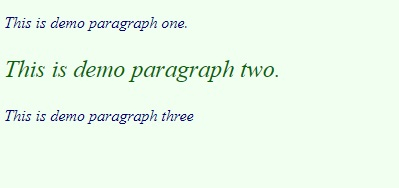◎欢迎参与讨论,请在这里发表您的看法、交流您的观点。
在CSS中导入外部样式表
ID:13112 / 打印我们可以在另一个css声明中导入额外的css文件。@import规则用于此目的,它在文档中链接样式表。通常在一个样式表依赖于另一个样式表时使用。它在
标签内的@charset声明之后的文档顶部指定。Syntax
@import规则的语法如下:
@import /*url or list-of-media-queries*/
The media queries can be compound statements which may specify the behavior of the document in different media.
Example
The following examples implement the @import rule −
HTML document −
立即学习“前端免费学习笔记(深入)”;
<!DOCTYPE html> <html> <head> <style type="text/css"> @import url(style.css); body { background-color: honeydew; } </style> </head> <body> <p>This is demo paragraph one. </p> <p class="two">This is demo paragraph two.</p> <p>This is demo paragraph three</p> </body> </html>CSS文档:style.css
p { color: navy; font-style: italic; } .two { color: darkgreen; font-size: 24px; }输出
这将产生以下输出 −

示例
HTML文档 −
<!DOCTYPE html> <html> <head> <link rel="stylesheet" type="text/css" href="style.css"> </head> <body> <div></div> </body> </html>
CSS文档−
div { height: 50px; width: 100px; border-radius: 20%; border: 2px solid blueviolet; box-shadow: 22px 12px 3px 3px lightblue; position: absolute; left: 30%; top: 20px; }输出
这将产生以下输出 −

